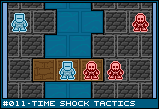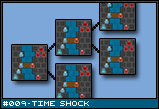| Three Hundred |
| - Index Page |
| - About... |
| - By Year |
| Collections |
| - Comp-Grid |
| - Procedural |
| - Tactics |
| - Tiny Crawl |
| - Misc |
| Previous | Mechanic #011 | Next |
This is slightly different than the past stuff. While the past ideas have been sort of high concept, structural mechanics, this entry is more concerned about tailoring mechanics to a specific problem: in this case, the unique needs of Mechanic #009 - Time Shock. This is a pretty simple tactical game. The mechanics are not particularly original, but I have tried to select the best mechanics for the job.
![[ts-tactics1.png]](set01/img/entry011-ts-tactics1.png) This is the illustration I'm starting with. The idea doesn't have to be on a hex grid, but what the heck. It's workable. The board is small and should be relatively simple. Repeating it over multiple instances would not be too confusing, though there should be a few landmarks to reference unit positions at a glance. Terrain works like terrain in any game, but simpler. Either you can move through a tile, you cannot move through a tile, or you must stop upon entering a tile (like marshland or something). Special attributes may allow units to move through specific terrain, like flying over water. Terrain does not block line of sight, even when solid, but can add a small bonus to defense to a unit on top of it. ![[ts-tactics3.png]](set01/img/entry011-ts-tactics3.png) Here is a half assed attempt to pretty it up using actual hex tiles and some old half-finished isometric characters. Truth be told, I like the previous square-based one better, but since I already made this and this entry is kinda hurting for illustrations, I'm still sticking it in.
Each unit has a few very basic stats. At the most basic, a unit can move X number of hexes, and attacks within a range of Y. There are different patterns for movement and attack. For instance, a Swordsman may move 2 hexes in any direction, and attacks any one thing within melee range. However, a Wolf may move up to four hexes, but only in a straight line, and may only attack the next square in the line after his movement (if he hasn't moved, he can attack an adjacent enemy). So, these numbers are specified with a pattern. For example:
In an effort to make keeping track to the board and units on it, there will be no internal state for any of the units. That is, they won't have hit points or spell points or anything like that. Either they are alive at full power, or dead. So, each unit is a static entity, like a chess piece. They may differ from each other, but one Swordsman will always be identical to another. Less house keeping. ![[ts-tactics2.png]](set01/img/entry011-ts-tactics2.png) The one exception is that they may have a status ailment or buff. These will have to be accompanied by unique and obvious visual effects. If a unit is poisoned (maybe has a 2% chance of dying each round), it should be colored green with little green bubbles floating above it. There should also only be one status buff/ailment at a time, and they should be prioritized. Ailments should always overrule buffs, and certain ailments should take precedence over others. For instance, wounded (DEF 0, can't move) should overrule poisoned. Status effects should not have counters (no internal states, remember). Instead, they will be active for the entire duration of the match, or perhaps have a static chance of going away at the end of a turn.
Combat works on a very simply equation. Each unit has an attack value of 0-5 and a defense value of 0-5. The base chance to hit is 60%. Subtract defense of the target from attack of the target, and add 10% for each value left. A successful hit removes the target from the board.
So, a Swordsman has a 60% chance to hit a Wolf, but only a 50% chance to hit another Swordsman. Obviously, with this formula, there is going to be a fair amount of missing, and it will be balanced at 60% (slightly weighted on the attacker's part)for the average unit. If the success chance is ever greater than 100% (ATK 5, DEF 0), it is just treated as an automatic hit - but could make a difference if there is a status ailment. With even the worst units against the best (ATK 0, DEF 5), there will still be a 10% chance of hitting.
Now the meat and potatoes of the idea. Units are split into three types: Pawns, Knights, and Kings. At the beginning of a match, you get one King unit and up to, let's say, 6 points. Each Pawn is worth 1 pt, and each Knight is worth 2 pts. Basically, design your team from the available options, selecting a King and however many Knights and Pawns you'd like. There is a fourth class of unit, Fodder, that are worth 0 pts, but they are not units you select up front.
Pawns (1 pt) A Pawn is a very generic unit. Though there is some variety in stats and move/attack patterns, they have no innate special abilities beyond that. These represent your typical rank and file units, like swordsmen, wolves, archers, and stuff like that. Pawns have an upper limit for attack and defense of 3 (there are exceptions, but they tend to be severely handicapped in other areas). Here are some examples:
Knights (2 pts) Knights represent more unique units, usually with some sort of ability. This may be something that is active, like a special attack, or passive, like an innate ability. They also have an upper limit for attack and defense of 4. Here are some examples:
Kings (unique) The object of the game is to kill your opponent's King. Kings represent a very special type of unit. You may only have one per side, and each King can significantly alter how the game is played. They may have multiple special abilities or passive traits. Their attack and defense may reach up to 5. When a King is hit, rather than dying immediately, the King becomes wounded (movement and def reduced to 0). Here are some examples:
Fodder (summoned) A Fodder unit is a type of unit which is usually the result of summoning or spawning during the game, and as such. Fodder units may have special support abilities, but can move no more than 1 hex per turn, and have a permanent, non-upgradable 0 ATK and 0 DEF.
|


